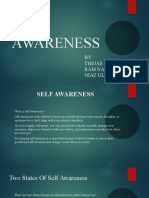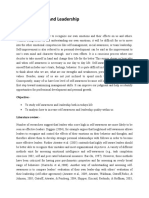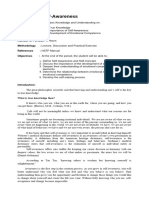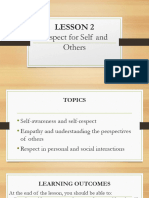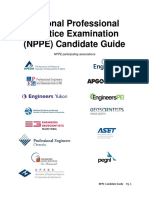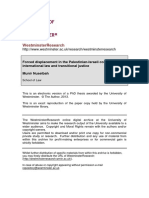Self-awareness refers to the ability to accurately assess one’s feelings, interests, values, and strengths
and to maintain a well-grounded sense of self and self-efficacy (Payton et al., 2008). Educators are better
equipped to teach and interact with students when they are aware of their own beliefs, values and
motivations, emotions, stressors, strengths, and weaknesses (Jennings, 2021). Further, when educators
have a deep understanding of their own backgrounds (including their cultural, religious, gender, and
racial backgrounds and identities) and better understand their identities as an educator, they can reflect
on how their own biases and assumptions may influence students (Jagers et al., 2018; Saavedra & Nolan,
2018). Likewise, educators’ self-awareness helps them understand how their backgrounds, values, and
experiences are similar or dissimilar to those of their students and how these can influence the
educators’ expectations and assumptions about their students (Jagers et al., 2018; Powell & Kusuma-
Powell, 2010).
Source: Nicholas Yoder, PhD
AMERICAN INSTITUTES FOR RESEARCH® | AIR.OR
A fundamental mission of schooling is to educate the “whole child” which includes promoting both
cognitive and noncognitive skills. Research has revealed schools to be one of the primary settings
promote social-emotional learning (SEL). SEL encompasses the processes through which individuals
attain and effectively apply the knowledge, attitudes, and skills necessary to identify and manage their
emotions; understand another’s perspective and show empathy for others; set and achieve positive
goals; develop and sustain positive relationships; and make responsible decisions. In a similar vein,
contemplative education seeks to educate the whole child, with a focus on developing mindful
awareness, values for moral living, caring for others, learning, and personal growth. Increasingly, school-
based primary prevention efforts are incorporating mindfulness-based practices, to foster attention,
resiliency, and well-being. Mindfulness is a state of consciousness that involves the direction of attention
that incorporates self-awareness with a core characteristic of being open, receptive, and nonjudgmental.
Both SEL and mindfulness-based initiatives in education emphasize the development of positive self,
moral, social, and emotional understanding. What has been missing in the literature is a clear
theoretical, empirical, and practical, articulation of how mindfulness-based practices align with SEL. This
article puts forth a conceptual framework that describes how mindfulness practices may deepen SEL
within K-12 educational contexts. Future directions for the field of mindfulness and SEL are also
discussed.
Source: Mindfulness and Social Emotional Learning (SEL): A Conceptual Framework
Handbook of Mindfulness in Education, 2016
ISBN : 978-1-4939-3504-8
Molly Stewart Lawlor
Self-awareness seems to have become the latest management buzzword — and for good reason.
Research suggests that when we see ourselves clearly, we are more confident and more creative. We
make sounder decisions, build stronger relationships, and communicate more effectively. We’re less
likely to lie, cheat, and steal. We are better workers who get more promotions. And we’re more-effective
leaders with more-satisfied employees and more-profitable companies.
�As an organizational psychologist and executive coach, I’ve had a ringside seat to the power of leadership
self-awareness for nearly 15 years. I’ve also seen how attainable this skill is. Yet, when I first began to
delve into the research on self-awareness, I was surprised by the striking gap between the science and
the practice of self-awareness. All things considered, we knew surprisingly little about improving this
critical skill.
Four years ago, my team of researchers and I embarked on a large-scale scientific study of self-
awareness. In 10 separate investigations with nearly 5,000 participants, we examined what self-
awareness really is, why we need it, and how we can increase it. (We are currently writing up our results
for submission to an academic journal.)
Our research revealed many surprising roadblocks, myths, and truths about what self-awareness is and
what it takes to improve it. We’ve found that even though most people believe they are self-aware, self-
awareness is a truly rare quality: We estimate that only 10%–15% of the people we studied actually fit
the criteria. Three findings in particular stood out, and they are helping us develop practical guidance for
how leaders can learn to see themselves more clearly.
There Are Two Types of Self-Awareness
For the last 50 years, researchers have used varying definitions of self-awareness. For example, some see
it as the ability to monitor our inner world, whereas others label it as a temporary state of self-
consciousness. Still others describe it as the difference between how we see ourselves and how others
see us.
So before we could focus on how to improve self-awareness, we needed to synthesize these findings and
create an overarching definition.
Across the studies we examined, two broad categories of self-awareness kept emerging. The first, which
we dubbed internal self-awareness, represents how clearly we see our own values, passions, aspirations,
fit with our environment, reactions (including thoughts, feelings, behaviors, strengths, and weaknesses),
and impact on others. We’ve found that internal self-awareness is associated with higher job and
relationship satisfaction, personal and social control, and happiness; it is negatively related to anxiety,
stress, and depression.
The second category, external self-awareness, means understanding how other people view us, in terms
of those same factors listed above. Our research shows that people who know how others see them are
more skilled at showing empathy and taking others’ perspectives. For leaders who see themselves as
their employees do, their employees tend to have a better relationship with them, feel more satisfied
with them, and see them as more effective in general.
It’s easy to assume that being high on one type of awareness would mean being high on the other. But
our research has found virtually no relationship between them. As a result, we identify four leadership
archetypes, each with a different set of opportunities to improve:
Source: Author: Tasha Eurich
Title: What Self-Awareness Really Is (and How to Cultivate It)
Year: 2018
�Site: https://hbr.org/2018/01/what-self-awareness-really-is-and-how-to-cultivate-it














